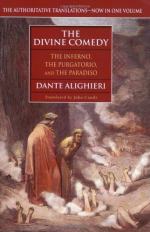|
This section contains 9,085 words (approx. 31 pages at 300 words per page) |

|
SOURCE: “Three Dreams,” Books Abroad, Vol. 39, May, 1965, pp. 81-93.
In the following essay, Stambler analyzes and interprets the three dream sequences in Purgatorio, discussing their function, roots in myth, sexual allusions, and implications.
The three dreams of Dante's Pilgrim in Purgatory constitute a mode of exposition or narration different from anything else in the poem. The dreams are markedly set off from the rest of the poem by the kind of experience they express as well as by the breaks in consciousness that introduce them, interrupting the normal flow of the Pilgrim's progress. And yet these dream-episodes, more than any other slices of comparable size, may be used to encompass the entire Commedia—its quality, function, and meaning—just as certain simple forms of life can regenerate themselves in entirety from a section placed in the appropriate broth or, as the biologist calls it, culture medium.
The observations...
|
This section contains 9,085 words (approx. 31 pages at 300 words per page) |

|


